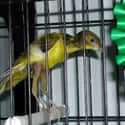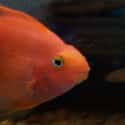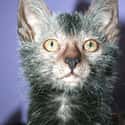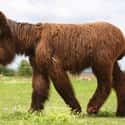-
(#4) This Bird Is Bred To Look Like The Number Seven
The gibber italicus canary looks more like a cartoon vulture than its cute yellow origin. Deliberately bred for its bizarre posture, which ideally makes it look like the number seven, this canary breed has sparse feathers and a nervous disposition that makes it ill-suited as a pet for anybody but expert breeders. This canary variant was produced after years of inbreeding to create its strange shape and feathers. While some selective breeding experiments can be cute, this one is more than a little bit creepy. What's even creepier is that its unclear why canary enthusiasts wanted to make this bird in the first place.
-

(#11) These Giant, Wrinkly Dogs Are The Result Of Years Of Selective Breeding
Want a dog that looks something like a kindly old man? You're in luck, because thanks to selective breeding, the Korean mastiff, or Mee Kyun Dosa, exists. These dogs are huge, wrinkly, and gentle, inbred specifically for their rich coat coloring. Their great personalities and striking appearance are a draw for fans of the breed, but unfortunately those years of inbreeding have led to a number of genetic health conditions, such as cherry eye, hip dysplasia, and other issues.
-
(#10) Blood Parrot Cichlids Are Slightly Less Terrifying Than They Sound
What happens when you combine two South American cichlids and mash them together? You create the blood parrot chichlid, a variety of fish bred to have a bright and colorful appearance. Unfortunately, blood parrots are also the subject of some controversy - selective breeding has given them a small vertical mouth that can make it difficult for them to chew. Though they can crush food with their throats, fish lovers have raised concerns that breeding a creature that can't eat effectively is unethical, leading to protests of shops that carry blood parrots.
-
(#14) West Highland White Terrier
- Animal breed
Westies - officially called west highland white terriers - are a beloved dog to many. But the history of these creatures is a little less wholesome. The dog comes from a breeding program in the early 20th century Scotland. Edward Donald Malcolm created this breed by crossing Scottish terriers and Polatalloch terriers.
Unlike other dogs who are a result of selective breeding, westies actually quite low maintenance dogs - which is why they're a favorite pet for elderly people. They do have some typical medical issues associated with selective breeding: hip dysplasia, cleft palate, and carniomandibular osteopathy, to name a few.
-
(#1) Lykoi Cats Look Like Lycanthropes
The origin of lykoi cats is a bit of a mystery. These cats are popular because they look like mini werewolves, which is how it got its nickname the "Werewolf Cat." The gene responsible for the werewolf-like appearance of lykoi cats appears to have developed on its own. The particular pattern of baldness is a genetic mutation unrelated to that of a sphynx cat. Now, breeders are actively trying to popularize the mutation and as of May 2017, Lykoi cats can be shown in The International Cat Association shows under Championship status.
-
(#13) Poitou Donkeys Almost Died Out
The poitou donkey is a unique creature - after centuries of breeding these massive, dreadlocked donkeys for their size and strength, their popularity began to dwindle. Machines replaced animals for farm work and there was less need for them, and in 1977, there were less than 50 remaining. Now conservationists are trying to revive the poitou donkey population.
New Random Displays Display All By Ranking
About This Tool
Selective breeding is the process by which humans control the reproduction of animals according to their own purposes. Select individuals with special traits that can be inherited to mate, thereby establishing breeding varieties with popular traits. Domestic dogs, sheep, and horses are all bred in this way. In addition to physical characteristics such as fur color, horn shape, etc., traits also include other physiological factors, such as egg and milk production and behavior.
It is not only used in agriculture and animal husbandry production, selective breeding is also helpful to genetics research. Here the random tool introduced 14 strange animals in real life that are the result of selective breeding.
Our data comes from Ranker, If you want to participate in the ranking of items displayed on this page, please click here.














